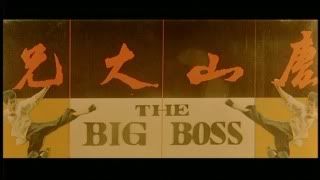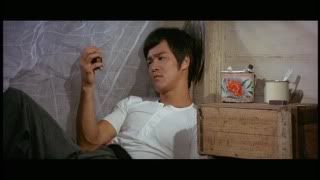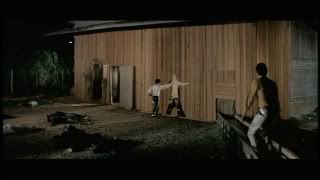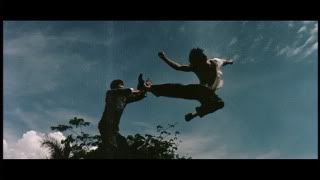Saturday, July 31, 2010
Capsule Review: Steamboat Bill Jr. (1928)
Perhaps best known for the scene of an entire building facade falling on Buster Keaton's William Canfield Jr., his life saved only by his body fitting through the scant space left by an attic window, Steamboat Bill Jr's rightfully praised finale is actually a cavalcade of destruction. In fact, the cyclone sequence that takes up the final quarter of the film is so impressive that it dwarfs the achievement of the rest of the film - one of Keaton's best as he plays a foppish youngster who humiliates his rough riverboat captain father. The fish out of water sequences are hilarious, with Ernest Torrence terrific as Canfield's irascible father - but the display of technical and physical prowess in the climax is what most audiences will remember.
Capsule Review: The General (1927)
Buster Keaton's finest hour, and perhaps the greatest of all silent film comedies, The General might not be as packed with gags as other Keaton efforts (though it's darn close), but they happen so fluidly - and are of such huge ambition - that it's nearly impossible to believe that most were made up on the spot. Keaton is terrific as Johnny Gray, a young engineer spurned by his beloved when he's rejected from serving in the Civil War. He gets a chance to prove himself when his locomotive is stolen, leading to some absolutely astounding comedy - both the physical stunts Keaton was renowned for as well as some tremendous feats of destruction. Keaton - like other comedy masters after him - realized that production values can fuel comedy, and his demonstrations of war - with an eye for period accuracy - are as polished as any of the period. Practically perfect.
Monday, July 26, 2010
The Collector (2009)

"Torture Porn" is now so clichéd that it has become a sub-genre of horror. Depressingly enough, the sub-genre has also fallen into most of the same traps that the beloved slasher film has. The irony of this metaphor will be revealed later in the review.
You can use the Saw franchise as a roadmap and litmus test of the torture horror genre much in the same way that you can use the Friday the 13th films to note the de-evolution of slasher films.
The first installation of the Saw franchise was a devilishly clever film full of mythology and malice. As the franchise wore on, the Saw films finally collapsed under their own weight as the murder devices themselves stole the spotlight from the enigmatic serial killer, Jigsaw.
Soon, the Saw films seemed to become less interested in telling Jigsaw's story and more interested in the exploration of the numerous ways the human body can be mangled beyond recognition. After that, to paraphrase Jigsaw's catchphrase, it was game over.
Just as it did in slasher films did before them, the "kill" became the star of the show in torture horror. The paradoxical disconnect with that line of logic is that the whole point of torture is that the subject is alive and suffering.
Oh well...
Mark Dunstan, the man who wrote many of the screenplays for the Saw films, came up with a script that he hoped would be the prequel treatment for Saw, but many of Saw's producers were against such a direction. Dunstan decided to turn the prequel into its own entity and now we have The Collector.
Here is where we determine whether or not that is a blessing or a curse.
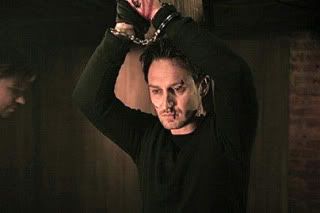
You can use the Saw franchise as a roadmap and litmus test of the torture horror genre much in the same way that you can use the Friday the 13th films to note the de-evolution of slasher films.
The first installation of the Saw franchise was a devilishly clever film full of mythology and malice. As the franchise wore on, the Saw films finally collapsed under their own weight as the murder devices themselves stole the spotlight from the enigmatic serial killer, Jigsaw.
Soon, the Saw films seemed to become less interested in telling Jigsaw's story and more interested in the exploration of the numerous ways the human body can be mangled beyond recognition. After that, to paraphrase Jigsaw's catchphrase, it was game over.
Just as it did in slasher films did before them, the "kill" became the star of the show in torture horror. The paradoxical disconnect with that line of logic is that the whole point of torture is that the subject is alive and suffering.
Oh well...
Mark Dunstan, the man who wrote many of the screenplays for the Saw films, came up with a script that he hoped would be the prequel treatment for Saw, but many of Saw's producers were against such a direction. Dunstan decided to turn the prequel into its own entity and now we have The Collector.
Here is where we determine whether or not that is a blessing or a curse.

The film prefaces the main body of the storyline with a bizarre abduction at the hands of the mysterious titular antagonist.
The film then shifts to the home of Michael and Victoria Chase (Michael Reilly Burke, Andrea Roth). Michael Chase is a gem broker overseeing renovations to his home and preparing to go on a family trip with his wife and their two daughters, Jill (Madeleine Zima) and Hannah (Karley Scott Collins).
Unbeknownst to Mr. Chase, his house is being cased by Arkin (Josh Stewart), a struggling locksmith who supports his income with the occasional house burglary. Arkin is a likeable chap stuck in a dire situation concerning his incredibly ungrateful wife and a loan shark. Over the course of the renovations to the Chase home, Arkin has discovered that Michael Chase is trying to negotiate the sale of a large ruby kept in a safe in the master bedroom.
Desperation forces Arkin to try to steal the gem earlier than he expected to. However in the course of breaking into the Chase's home that evening, Arkin soon learns that he wasn't the only one interested in what the Chase family had to offer.
Arkin then becomes the unwilling hero in a game of cat and mouse. Does he try to save himself and his own family, or does he stick out his neck for strangers by matching wits with a cold blooded madman?
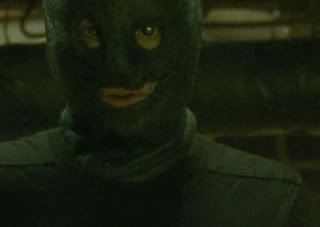
There are parts of The Collector that are very frightening but most of this sentiment is undermined by the absolutely hilarious figure that is the Collector himself. I'm sure that Mark Dunstan thought, "Ooooo, CREEPY!" the first time he got a gander of the trademark mask, but I personally found it to be so funny and out of place that it served to be a distraction.
How can you take a killer that wears a mask like that seriously? I think I am going to mail Dunstan copies of Halloween and Nightbreed so that he can see what scary masked killers are supposed to look like.
I know that the shining eyes and weird mask were suppose to give the Collector an inhuman quality much as the iconic Halloween mask did for Michael Myers, but the mask really does fall flat as a signature item.
The film then shifts to the home of Michael and Victoria Chase (Michael Reilly Burke, Andrea Roth). Michael Chase is a gem broker overseeing renovations to his home and preparing to go on a family trip with his wife and their two daughters, Jill (Madeleine Zima) and Hannah (Karley Scott Collins).
Unbeknownst to Mr. Chase, his house is being cased by Arkin (Josh Stewart), a struggling locksmith who supports his income with the occasional house burglary. Arkin is a likeable chap stuck in a dire situation concerning his incredibly ungrateful wife and a loan shark. Over the course of the renovations to the Chase home, Arkin has discovered that Michael Chase is trying to negotiate the sale of a large ruby kept in a safe in the master bedroom.
Desperation forces Arkin to try to steal the gem earlier than he expected to. However in the course of breaking into the Chase's home that evening, Arkin soon learns that he wasn't the only one interested in what the Chase family had to offer.
Arkin then becomes the unwilling hero in a game of cat and mouse. Does he try to save himself and his own family, or does he stick out his neck for strangers by matching wits with a cold blooded madman?

There are parts of The Collector that are very frightening but most of this sentiment is undermined by the absolutely hilarious figure that is the Collector himself. I'm sure that Mark Dunstan thought, "Ooooo, CREEPY!" the first time he got a gander of the trademark mask, but I personally found it to be so funny and out of place that it served to be a distraction.
How can you take a killer that wears a mask like that seriously? I think I am going to mail Dunstan copies of Halloween and Nightbreed so that he can see what scary masked killers are supposed to look like.
I know that the shining eyes and weird mask were suppose to give the Collector an inhuman quality much as the iconic Halloween mask did for Michael Myers, but the mask really does fall flat as a signature item.
The other things I found chuckle worthy were the whole idea of the traps that the Collector used and the time it took to deploy them. Most of the traps and gadgets were downright ingenious but there are some plot issues that rob me of my appreciation of their viciousness.
First of all, just about every one of the Collector's traps is potentially lethal in nature. For a killer whose modus operandi is abduction, his weapons of choice weren't exactly built with live capture in mind.
Secondly, the Collector apparently has time to litter the entire Chase home with mean-spirited little devices and turn ordinary rooms into killing zones in mere minutes. One minute Arkin is navigating the Chase home with no problem and the next, he is avoiding every peril imaginable from floors covered by pools of acid to foyers criss-crossed with ultra-thin razor wire.
It is the torture horror version of the television show, Wipeout, but without the charm. Either the Collector is a master planner or Mr. Dunstan has no sense of timing or pacing.
My guess would be the latter.
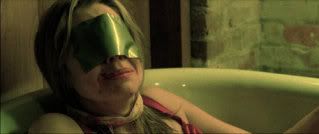
First of all, just about every one of the Collector's traps is potentially lethal in nature. For a killer whose modus operandi is abduction, his weapons of choice weren't exactly built with live capture in mind.
Secondly, the Collector apparently has time to litter the entire Chase home with mean-spirited little devices and turn ordinary rooms into killing zones in mere minutes. One minute Arkin is navigating the Chase home with no problem and the next, he is avoiding every peril imaginable from floors covered by pools of acid to foyers criss-crossed with ultra-thin razor wire.
It is the torture horror version of the television show, Wipeout, but without the charm. Either the Collector is a master planner or Mr. Dunstan has no sense of timing or pacing.
My guess would be the latter.

The one area where The Collector does show some sign of brilliance is in the characters.
It's pretty obvious that most of the members of the Chase family (smoking hot Madeline Zima included) are there to be torn to shreds. What is a torture horror movie without victims?
The shining light of this otherwise lackluster production is the tragic figure of Arkin. His life is a sad series of events that culminate in a life and death struggle against a vile maniac who has complete control of the playing field.
Arkin really has no say in the matter of burglarizing the Chase's home because the alternative could mean the death of his wife and possibly his child. As if this weren't bad enough, Murphy's Law kicks into overdrive as Arkin finds himself not only fighting for his survival, but struggling with his own sense of humanity.
Arkin has enough problems with the dark cloud hanging over his family. Now Arkin finds himself weighing the merits of either escaping and living with the shameful cowardice associated with allowing innocent people to die versus squaring off against a sadistic intruder and fighting for the lives of the very people he intended to steal from.
Talk about awkward.
The really sad thing is that most horror audiences know that one of the timeless morals of the genre is that "no good deed goes unpunished." As signs in the film point towards sequel, you can only lament the dark destiny that Arkin inevitably has waiting for him despite his desperate acts of selfless heroism.
Alice survived the first Friday the 13th film only to get an ice pick shoved into her brain in the second film. We can only hope that poor Arkin doesn't suffer a similar fate.
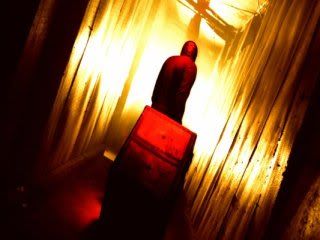
I know it is an old and shopworn criticism, but there are tons of movies that do what The Collector does much better than The Collector. If you are a fan of torture horror, then The Collector does represent one more title for the catalogue and that is something to be thankful for.
Also, as a torture horror fan you can find comfort in the idea that even the most disrespected torture horror film is probably head and shoulders better in quality than the worst slasher movie. As taxing and somewhat droll as I found The Collector to be, I can name dozens of slasher films that are a thousand times more lame than this film.
There are certainly worse ways to burn ninety minutes and I have experienced quite a few.
I think with a bit more polish, The Collector might've had a real shot at being the proverbial instant classic. For now, we'll have to wait for the sequel to arrive later on this year and hope that it is an improvement.
If the Collector is still wearing that goofy mask, I doubt it.
It's pretty obvious that most of the members of the Chase family (smoking hot Madeline Zima included) are there to be torn to shreds. What is a torture horror movie without victims?
The shining light of this otherwise lackluster production is the tragic figure of Arkin. His life is a sad series of events that culminate in a life and death struggle against a vile maniac who has complete control of the playing field.
Arkin really has no say in the matter of burglarizing the Chase's home because the alternative could mean the death of his wife and possibly his child. As if this weren't bad enough, Murphy's Law kicks into overdrive as Arkin finds himself not only fighting for his survival, but struggling with his own sense of humanity.
Arkin has enough problems with the dark cloud hanging over his family. Now Arkin finds himself weighing the merits of either escaping and living with the shameful cowardice associated with allowing innocent people to die versus squaring off against a sadistic intruder and fighting for the lives of the very people he intended to steal from.
Talk about awkward.
The really sad thing is that most horror audiences know that one of the timeless morals of the genre is that "no good deed goes unpunished." As signs in the film point towards sequel, you can only lament the dark destiny that Arkin inevitably has waiting for him despite his desperate acts of selfless heroism.
Alice survived the first Friday the 13th film only to get an ice pick shoved into her brain in the second film. We can only hope that poor Arkin doesn't suffer a similar fate.

I know it is an old and shopworn criticism, but there are tons of movies that do what The Collector does much better than The Collector. If you are a fan of torture horror, then The Collector does represent one more title for the catalogue and that is something to be thankful for.
Also, as a torture horror fan you can find comfort in the idea that even the most disrespected torture horror film is probably head and shoulders better in quality than the worst slasher movie. As taxing and somewhat droll as I found The Collector to be, I can name dozens of slasher films that are a thousand times more lame than this film.
There are certainly worse ways to burn ninety minutes and I have experienced quite a few.
I think with a bit more polish, The Collector might've had a real shot at being the proverbial instant classic. For now, we'll have to wait for the sequel to arrive later on this year and hope that it is an improvement.
If the Collector is still wearing that goofy mask, I doubt it.
Friday, July 23, 2010
The Big Boss (1971)
Very rarely, and often without warning, all the elements come together to create a full-fledged film superstar. The Big Boss (alternately - and confusingly - known as The Chinese Connection and Fists of Fury in North America) was the film that launched Bruce Lee as an international force to be reckoned with, and it's easy to see why audiences flocked to watch the charismatic kung-fu master in action. However, while credit must be given to the filmmakers for recognizing that they had captured lightning in a bottle, inevitably the film works better as a showcase for Lee than as a unique piece of martial arts cinema.
In fact, originally the film was to star established actor James Tien in the lead - and those watching for the first time may be excused for wondering why the first half focuses so obviously on Tien's character. It was the rather astute recognition of Lee's abilities which led to the expansion of his role, and his character's reluctance to fight (because of a promise to his mother) eventually gives way to Lee dispatching groups of baddies with his trademark intensity. While the plot is a fairly standard modern-day revenge story, the near-accidental build to Lee's explosive style of kung-fu - as well as its eventual release - becomes much more captivating than the uncovering of a drug smuggling operation.
Lee plays Cheng Chao-an, who travels to Thailand with his Uncle in order to find work in an ice factory with his cousins. After discovering a bag of white powder hidden in some broken ice, two of Cheng's cousins are killed to keep them quiet. Apparently there isn't a lot of money in the ice business, but the drug smuggling business is quite profitable. The remaining workers (led by James Tien's Hsu Chien) demand to know the whereabouts of the missing pair, and Hsu Chien eventually confronts the Big Boss, Hsiao Mi, but is also murdered for his efforts. When Cheng's own suspicions grow he's promoted to the position of foreman - and bribed with alcohol and prostitutes by Hsiao Mi. While fending off resentment from the remaining cousins, Cheng uncovers the drug smuggling operation - which eventually leads to a one-on-one confrontation with the big boss.
While Lee's influence on cinema, and particularly martial arts cinema, was revolutionary in a number of ways, what jumps out when watching The Big Boss is his contribution to kung-fu choreography. While the fights in the film's first half are entertaining, they mostly feature characters flailing about messily without much specific purpose. Lee's fights are a revelation, as he throws out lightning fast kicks and bone-shattering punches. His fighting has impact and is amazingly focused, which was obviously hugely influential on the Golden Harvest and Shaw Brothers films released throughout the rest of the decade.
But it wasn't just Lee's fighting abilities that eventually made him an international superstar. While The Big Boss isn't going to win any acting awards, Lee is terrific as a character with almost superhuman abilities boiling inside of him. But it's the flashes of playfulness and humor that make him such an appealing character. As the big boss, Han Ying-chieh - who also choreographed much of the action - is appropriately fiendish while James Tien is really quite good as the hurriedly pushed aside Hsiu Chien. Genre fans will recognize the late Lam Ching-ying (Eastern Condors, Mr. Vampire) in a small role.
I was actually a little surprised by the amount of bloody violence in the film. While Chang Cheh would later bring his special mix of blood and kung-fu later in the decade, there quite a bit of bloodletting - especially in an infamous scene where two character's bodies are disposed of using a buzzsaw. While the scene his been obviously edited down, it's still a bit startling. Even Bruce gets in on the action, particularly in his final confrontation with the Big Boss. Apparently there were even more violent scenes left on the cutting room floor, but i'll admit that I didn't expect these exploitive elements in what I thought to be a rather tame kung-fu film.
Director Wei Lo would later go on to direct both Fist of Fury and the Jackie Chan vehicle New Fist of Fury, and he does an adequate job of shooting the action scenes. Unfortunately, he does add a few campy elements - like Cheng punching a baddie so hard he leaves a cartoon outline in a wall - that seem out of place considering the surrounding violence.
Available in countless DVD versions of varying quality (and lengths), the 2005 DVD release from 20th Century Fox treats the film with some welcome respect. The Big Boss is presented in 2.35:1 anamorphic widescreen, and it blows all previous editions that I've seen out of the water. Despite what appeared to be a low budget, the film shows little of the grain or film damage common with martial arts films of this period. Just a great looking DVD. As well, fans are given the option of four different audio tracks: English 5.1 or DTS, Cantonese 2.0, or Mandarin 2.0. Of course there are optional English subtitles available. The Cantonese and Mandarin versions have two completely different scores, and viewers will be tickled to hear snippets from Pink Floyd and King Crimson in the Cantonese version. I don't care for English dubbing, even in kung-fu films, so I watched the very enjoyable Mandarin version. I noticed a few grammatical and spelling errors in the subtitles, but nothing that would be particularly distracting.
While it doesn't come close to matching the special features available on the Hong Kong Legends region 2 DVD releases (which have commentaries and deleted scenes), 20th Century Fox have been good enough to include the original trailer for the film, a second (particularly cheesy) new trailer, a photo gallery and slideshow, and a two and a half minute interview with actor/director Stephen Tung Wai. There are also extra trailers for City Hunter, The Young Master, The Iron-Fisted Monk and Prodigal Son.
A messy and unbalanced film, The Big Boss might not be spectacular entertainment, but it does an adequate job of showing off the acting and martial arts skill of Bruce Lee. In fact, Lee so trumps his surroundings that the film practically limps when he's not on-screen - which makes the first hour a bit of a trial. Still, patient viewers will be rewarded when he's unleashed in the film's final half hour, delivering bloody beatings in a way that only Bruce ever could. Historically important, but not worth rushing to see.
Monday, July 19, 2010
Cobra Verde (1987)
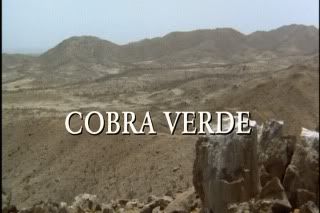
PLOT:
The final film in the legendary collaboration between director Werner Herzog and actor Klaus Kinski, COBRA VERDE--based on a novel by Bruce Chatwin--tells the story of Francisco Manoel da Silva, a poor farmer who raises himself to fame and notoriety as the bandit “Cobra Verde.”
The film begins with a blind minstrel beginning to sing the tale of the famed bandit. Da Silva is shown kneeling before a cross; surrounding him is a dead, parched landscape. It’s only because I read a synopsis of the film that I know that this is supposed to be his land, destroyed by draught (the film itself makes no mention of this). And so da Silva is forced into a job as a gold miner, only to disagree with his foreman over his payment. Having exhausted the legitimate means available to him for making a living, da Silva murders the foreman and turns to a life of crime, as the bandit Cobra Verde.
Soon, he finds himself in the employ of a sugar baron named Don Octavio Coutinho. Rather than attending to his duties, da Silva impregnates each of the sugar baron’s three daughters, before revealing himself as the bandit Cobra Verde. As punishment, he is sent to the African kingdom of Dahomey, where he is to reopen the slave trade by negotiating with the mad King Bossa Ahadee. The sugar baron assumes that Cobra Verde will fail, and be murdered in the process. Of course, the bandit succeeds, becoming the Viceroy of Dahomey, and eventually leading an army of amazons in the process.

REVIEW:
COBRA VERDE is often considered the weakest of the Herzog-Kinski collaborations. I have to disagree with this popular assessment. I find the alienation in WOYZEK is so intense that I, as the viewer, felt it as well, and in doing so was almost completely unable to enjoy the film. And something about NOSFERATU has never sat right with me, as much as I admire it. COBRA VERDE, on the other hand, is as engrossing as the earlier Herzog-Kinski collaborations, AGUIRRE and FITZCARRALDO.
This film is different than those two, though, in very important ways. For one, the focus in both of those films is the obsession (and insanity) of the main character, as played by Kinski. They are character-driven, rather than plot-driven (and indeed almost all of these films suffer from a lack of clear narrative, to my mind). COBRA VERDE, on the other hand, is a plot-driven piece; it has a detailed narrative, with several easily-distinguishable acts, as well as lots of action.
Among the chief pleasures to be derived from any Herzog film is the filmmaker’s eye for composing a breathtaking shot, and his engagement with the world of the film. Look how he uses the colourful costumes of the Dahomey people to serve as a living background for Cobra Verde:
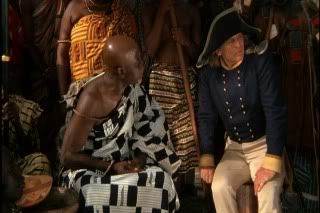
There are almost no sets in Herzog’s films; everything is shot on location, using real buildings, and often real people (as opposed to “fake” actors, I suppose). It adds an element of reality to his films that doesn’t necessarily make a “better” movie, but it has a striking effect that you can’t find elsewhere. For instance, the image that first comes to my mind, when I think of FITZCARRALDO, is scene where the tribesmen begin cutting down an immense and ancient tree. I mean, they’re really cutting down this tree, doing real, irreparable violence to nature. And I think you feel that violence.
Herzog’s fictions, then, are like a weird marriage of documentary and drama, and instead of the two genres clashing, they somehow serve to illuminate each other. And so you get to see the “fake” action of Cobra Verde in the “real” wilderness of Brazil, or in the landscapes of Ghana (serving as Dahomey). He uses a real Ghanaian choir, and lets them have ample time to sing; near the end, he shows the audience a real Ghanaian suffering from polio; the man’s twisted figure serves as a shocking and powerful symbol of the film’s themes. Herzog also uses long takes, with minimal cutting; the effect, I think, is to let the viewer sit back and take in the scene, and to be assured that there are no tricks being played.
So, COBRA VERDE is an immensely beautiful film. Herzog uses the colourful dress of the Ghanaian (Dahomians?) to the fullest, and--as in FITZCARRALDO, AGUIRRE, et. al.--captures the landscape like no other director out there. And Klaus Kinski, of course, is Klaus Kinski; wild, intense, and always unpredictable.
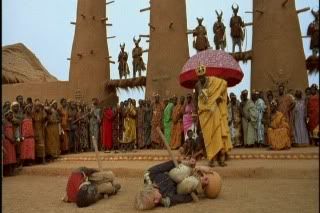
Which isn’t to say that COBRA VERDE isn’t without its faults. The first fifteen minutes or so are incredibly hard to follow, with no exposition to help the viewer along the way. There’s a shot of Cobra Verde surrounded by desolation; you have to infer that this is his land. There’s a run in, near the start of the film, between the bandit and a cripple; the crippled man tells some fantastic tales to Cobra Verde, but it’s unclear what the connection is to the rest of the film. As well, there’s almost no sense of time passing. From the first scene of da Silva as a poor rancher, to the first scene where he is identified as Cobra Verde, one must infer that time has past, but there’s no telling how much. How long does it take the bandit to impregnate Don Coutinho’s daughters: months, or days? You can’t tell, from watching the film. And it’s unclear how long Cobra Verde is in Dahomey before things go screwy. However, if you can struggle through the first few scenes, and simply accept that you’re going to be shown quite a show, even if it’s somewhat disjointed, then you’re in for a treat. COBRA VERDE is one of Herzog’s most under-appreciated films.
Saturday, July 17, 2010
Rikidozan: A Hero Extraordinary (2004)

On December 15th, 1963, Rikidozan, founder of puroresu, died of peritonitis--the cause of which, or so the story goes, was a yakuza’s blade, soaked in urine. He died a rich and famous man, whose legacy still lives on.
Rikizodan’s journey to the top was an odd one: born in Korea as Kim Sin-Rak, the young Rikidozan moved to Japan (where he changed his name to Mitsuhiro Momota) to become a sumo. He left sumo in 1950; according to the film, this was due to the glass ceiling in place because of his Korean nationality, and Japanese racism. And so Rikidozan went to America, where he learned the distinctly American combat sport/performance art of pro wrestling. Riki then made a name for himself by returning to Japan, passing himself off as Japanese, and importing American-style pro wrestling to his adopted country. He struck it big by booking himself as the strong Japanese hero who could overcome all American aggression. In the years following the atomic bomb, there was something of an audience for this.
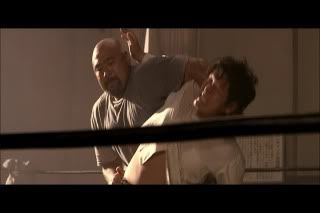
Song Hae-sung’s RIKIDOZAN: A HERO EXTRAORDINARY is a good looking film, with some decent performances, and it benefits from the profoundly interesting life it portrays. It’s not, however, a very good movie; unfortunately, it doesn’t just dip deep, deep into melodrama--it overindulges in it. It gorges on melodrama. It’s practically a fucking soap opera.
There will be some who find that fitting, for a film about a pro wrestler. Darren Aronofsky’s THE WRESTLER, however, showed how these sorts of things could be done. In RIKIDOZAN, for instance, they tip-toe around the actual legitimacy of pro wrestling--they hint that it’s not entirely on the up and up, but they’re altogether unwilling to discuss it openly, and for what it is, which hampers the storytelling.
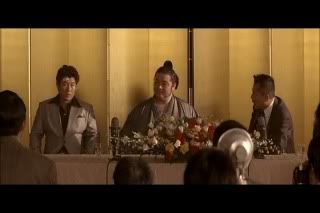
RIKIDOZAN: A HERO EXTRAORDINARY depicts the puroresu hero (played by beefy Korean actor Sol Kung-gu) as an incredibly troubled man. At least this isn’t hagiography. Not only does the film show him as incredibly hubristic, but it paints him as an incredibly paranoid man. When a group of children, gawking at their hero from a second or third storey window, accidentally know a flower pot from the ledge, Riki construes it as an assassination attempt. More to the point, though, the film depicts Riki’s death in a way that goes totally against the standard story--but now we’re talking about the last ten minutes of the film, and I’ll have to leave that a mystery.
For those who are fans of puroresu, the principle pleasure to be derived from watching the film comes from spotting many of the wrestling stars of the time. Hey, there’s Keiji Muto (The Great Muta)! Hey, there’s Shinya Hashimoto, (rather appropriately) playing a sumo! Hey, isn’t that Masakatsu Funaki? And oh, what’s Rick Steiner doing there?
For a film about a pro wrestler, though, there certainly seems to be a dearth of actual wrestling. I think only three matches are shown, and each one is terribly truncated. Presumably, anyone watching a film about a wrestler likes wrestling, and would like to see more of it.

I could only recommend RIKIDOZAN to anyone who is already familiar with, and interested in, the wrestler himself. As a movie, it’s a bit flat, but it’s also the only film you’re going to find on the subject matter.
Subscribe to:
Posts (Atom)

.jpg)

